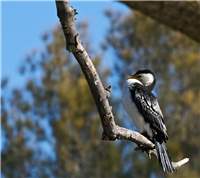Family
Phalacrocoracidae
Genus
Phalacrocorax
Species
melanoleucos
Threats/Control Methods - Regional
In times of prolonged drought, species numbers decline, as they will only breed when the water levels around a waterbody exceed a certain level. They are threatened by the diversion of water away from naturally flowing rivers and wetlands into irrigation and human use.
Threats/Control Methods - Local
Water bodies in urban areas are less resilient against periods of droughts or extreme weather events, causing a build-up of toxins and dangerous algae levels, which may impact the health of this species. In particular, the Jerrabomberra Creek Catchment, home to many of the local Little Pied Cormorants, is currently degraded from grazing, polluted stormwater from the Hume industrial estate, road surface runoff and rural residential developments.
Local/Urban Actions
It is important that our waterways remain free from pollution, to encourage healthy aquatic species. Joining in with a local Waterwatch activity can help improve water quality. At home, it is important avoid chemicals, pet faeces or garden waste going down the stormwater drain. Keep gutters clean and call the Canberra Connect helpline on (02) 6207 9777 for specific chemical waste disposal information. Joining a Landcare revegetation activity around a local waterbodies will also improve the habitat areas for this species.
Common Names
Little Pied Cormorant, Frilled Shag, Little Black-and-white Cormorant, Little Black-and-white Shag
Distinguishing Features
This bird is black on is back, wings and tail, with white underparts and a yellow and black bill. It has a blunt hooked bill and dark webbed feet. In the breeding season, they develop a spiky black crest on the top of their head. They are 55-60cm in size, with a dark eye surrounded by a white face. Young birds are similar, except they have black colouring above the eye. Very young nestlings have bare reddish skin on their head.
Survey Techniques
Call and visual identification.
Species Call
A nesting 'keh-keh-keh-' or a harsh, deep 'uk-uk-urk'.
Similar Species
The Peid Cormorant (Phalacrocorax varius) is a larger bird with almost identical colourings. At close range, their yellow, blue and pink bare facial skin is noticiable.
Distribution
The Pied Cormorant is likely to be found around any body of water across most regions of Australia, excluding the most arid central regions. They are also found across eastern Indonesia, New Guinea, New Zealand and on several of the southwest Pacific islands.
Country of Origin
Australia
Conservation (Pet/Pest) Status - Regional
This species is rare to the Canberra region, with most records from the Jerrabomberra Wetlands. They are more common in the cooler months.
Conservation (Pet/Pest) Status - National
Secure, not listed under the EPBC Act 1999.
LSCCES Population
Most sightings were made at the NMA, with some birds seen on the lake's edge at Civic West, BMP and ANU.
Associated vegetation community
This species will inhabit a wide range of watered areas, including lakes, dams and floodwaters. They are also often seen in sheltered coastal lagoons, harbours and bays.
Limiting Resources
Little Pied Cormorants depend on a variety of larger aquatic food species for their diet and on vegetation surrounding a waterbody. Rainfall is important, as they will only breed when water levels around wetlands are extremely high.
Breeding
This species breeds in colonies in well-vegetated wetlands. Nests are positioned in the trees overhanging the water, in bushes or sometimes on the ground. They are platforms of sticks and bark of about 30-35cm in diameter. The 3-5 white, blue-tinted eggs have a white chalky coating. The parents take turns in incubating the eggs with their webbed feet.
Behaviour
Little Pied Cormorants are most likely to be seen sunning themselves on bare branches, stumps or walls around water bodies. Here, they shake water off and preen themselves after swimming, with their wings outstretched. The birds swim to catch fish, sometimes seen paddling on the surface. In the breeding season, male birds call from their chosen nesting site, bowing low with raised wings in display for his appointed female.
Functional Group
Food Species
The strong bill allows this species to hunt crustaceans, yabbies (Cherax destructor) in particular. Carp (Cyprinus carpio) and redfin (Perca fluviatilis) are the preferred fish species and are eaten where available.
Predators
Adult Little Pied Cormorants guard their nests carefully, with a watchful eye and a strong bill, and are less prone to attacks from common predators.
Interesting Fact
Little Pied Cormorants have specially designed nasal salt glands that allow them to swim and fish through seawater and then flush out any excess salt swallowed.
References - (reader suitability of references, P=Primary teachers, S=Secondary students, T=Tertiary students and researchers)
Books:Morcombe, M. 2000. Field Guide to Australian Birds. Steve Parish Publishing. Archerfield. Australia P, S, T
Schodde, R. and Tideman, S. (eds) 1990. Reader's Digest Complete Book of Australian Birds (2nd Edition). Reader's Digest Services Pty Ltd. Sydney. P, S, T
Taylor, M. and Day, N. 1993. Field Guide to the Birds of the ACT. National Park Association of the ACT Inc. Canberra. P, S, T
Veerman, P. 2003. Canberra Birds: A report on the first 21 years of the garden bird survey. Philip Veerman and Canberra Ornithologists Group. Canberra. S, T
Internet: Canberra Ornithological Group (COG). 2004. Birds of Canberra Gardens. COG and the ACT Department of Urban Services. [online]. Available at:http://garden.canberrabirds.org.au/ P, S, T
Online Publications:ACT Government. 2006. Information Sheet: Stormwater Pollution from Residential Areas. Environment ACT. [online]. Available at: http://www.environment.act.gov.au/__data/assets/pdf_file/13168/Stormwater_Pollution_from_Residential_Areas.pdf P, S, T
Nix, H. and Cunningham, R. 2006. Birds of the Lower Sullivans Creek Catchment, Canberra ACT. Prepared for the Life in the Suburbs project using data from the Lower Sullivans Creek Catchment Ecological Survey (LSCCES). Australian National University. Canberra. [online]. Available at: http://www.lifeinthesuburbs.com.au/category.php?id=65 S, T
Queanbeyan City Council. 2004. Study on the Current State of Jerrabomberra Creek . Maunsell Australia Pty Ltd. Canberra. [online]. Available at: http://www.qcc.nsw.gov.au/Documents/YRJTKVCEDKP.pdf S, T
Olsen, P. and Weston, M. 2004. The State of Australian Birds 2004: Water Wetlands and Birds. Birds Australia. [online] Available at: http://www.environment.gov.au/biodiversity/publications/birds-04/regional.html S, T

 Top
Top Top
Top